Key Takeaways
- Focus on overall ROI by optimizing your sales funnel, simplifying checkout, and making data-driven decisions to increase your eCommerce ROI effectively.
- Boost conversion rate optimization through A/B testing, responsive design, and personalized customer experiences to encourage potential customers to make a purchase.
- Increase sales by investing in high-impact marketing channels like SEO, PPC, and email campaigns while leveraging social media platforms to connect with potential customers.
- Retain existing customers with personalized loyalty programs, targeted offers, and seamless user experiences that build trust and foster long-term relationships.
- Track and analyze KPIs like customer acquisition costs, cart abandonment rates, and average order values to refine strategies and improve ROI through actionable insights.
- Diversify sales channels to reach more customers, from marketplaces like Amazon to social media shops, and maintain consistent branding across platforms for a higher ROI.
eCommerce ROI Basics
What is eCommerce ROI?
ROI, or return on investment, measures how profitable your online business activities are.
It tells you how much profit your eCommerce strategies generate for every dollar you spend.
This insight helps you understand what’s working in your business and what isn’t.
For instance, knowing your ROI allows you to gauge the profitability of your marketing campaigns, operational expenses, and other business efforts.
It’s a key way to assess the overall profitability of your eCommerce business.
There are two main ways to approach ROI measurement: net profit-based and CLV-based (customer lifetime value).
Each provides valuable insights into different aspects of your business performance.
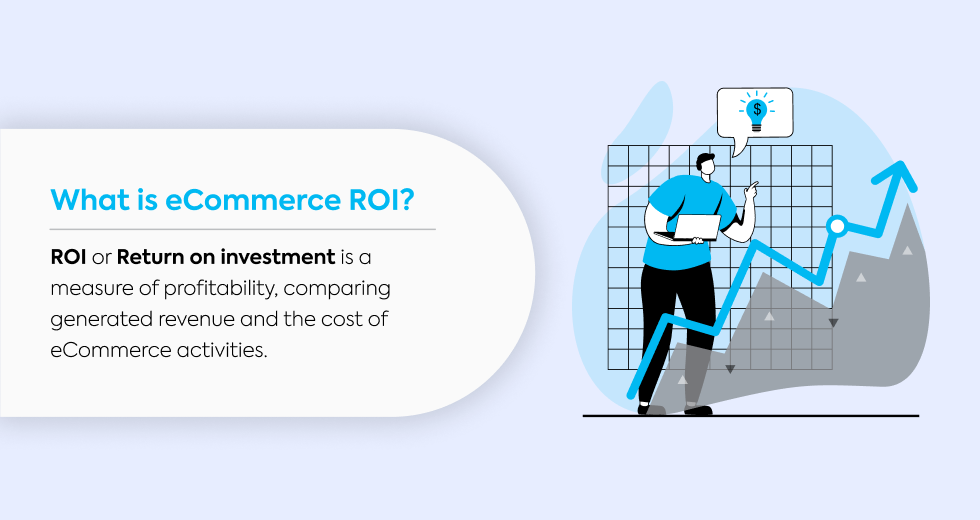
How to Calculate eCommerce ROI
Formula for ROI Calculation
To calculate ROI, use this simple formula:
ROI (%) = [(Net Profit - Total Costs) / Total Costs] x 100
Net profit is calculated by subtracting your total costs—such as product costs, marketing expenses, and operational costs—from your total revenue.
For example, if you spend $1,000 and make $1,200 in profit, your ROI is 20%.
Multiplying the result by 100 converts the ratio into a percentage, making it easier to understand.
ROI helps you pinpoint the effectiveness of your investments, whether in marketing, website optimization, or other areas of your business.
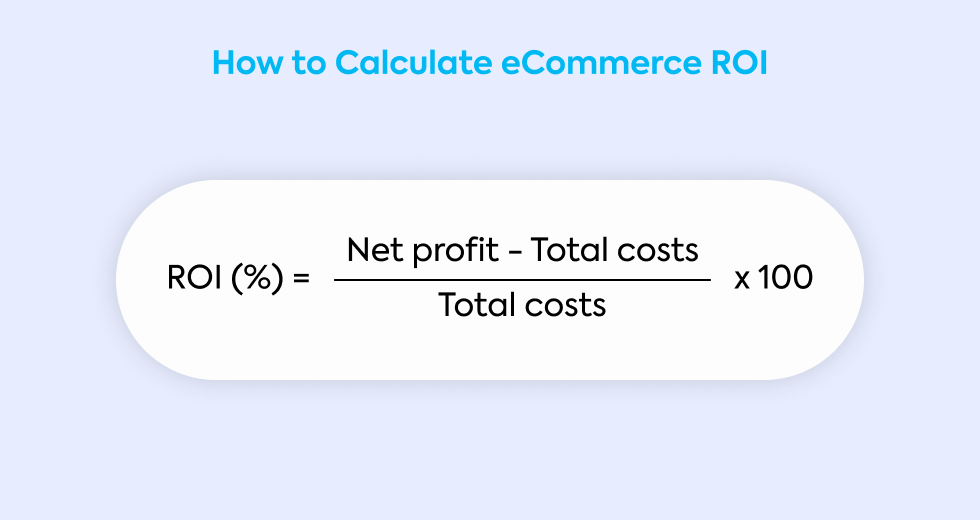
Using Customer Lifetime Value (CLV) in ROI
Looking beyond initial transactions, CLV-based ROI focuses on repeat purchases and the long-term potential of your customers.
It considers how much revenue a customer generates over time.
Here’s the formula for this approach:
ROI (%) = [(CLV - Customer Acquisition Costs) / Customer Acquisition Costs] x 100
Factors like how often customers buy and how long they remain engaged with your business affect the accuracy of customer lifetime value calculations.
For example, when you acquire a new customer who continues to shop over the years, their total value to your business far exceeds just the initial purchase.
This method highlights opportunities to nurture repeat purchases and unlock the long-term potential of loyal customers.
It’s a powerful way to view ROI from a broader perspective.
Strategies to Boost eCommerce ROI
Optimize Your Website for Conversions
To significantly boost your eCommerce ROI, start by focusing on website optimization.
A smooth shopping experience is key to driving higher conversion rates.
For instance, simplifying the checkout process—like reducing unnecessary steps and offering a guest checkout option—can help more visitors complete their purchases.
Product pages play a huge role in influencing decisions, so make sure they stand out with high-quality images and detailed descriptions.
Building trust is another important step. Add elements like customer reviews, ratings, and secure payment icons to make your site more credible.
Testing is also important. Use A/B testing to identify changes that result in higher conversions, like tweaking page layouts or call-to-action buttons.
Don't overlook mobile users either—responsive designs, fast loading times, and intuitive navigation help improve the shopping experience across all devices.
Finally, urgency features, such as countdown timers or stock indicators, can nudge hesitant shoppers to act quickly.
Invest in High-Impact Marketing Channels
Effective marketing strategies can drive more traffic to your store and improve ROI.
Digital marketing methods, like SEO, are great for increasing visibility by targeting specific keywords and building backlinks.
To see immediate results, consider PPC campaigns, such as Google Ads, which can bring in quick conversions.
Social media platforms like Instagram and TikTok are valuable for connecting with your target audience, especially younger demographics.
Email marketing also plays a significant role in nurturing leads.
Segmented campaigns and automated sequences can deliver personalized messages that increase engagement.
Diversifying your revenue streams is another powerful strategy.
Selling on marketplaces like Amazon or Walmart helps you reach customers who might not visit your store directly.
And don’t forget to retarget visitors who abandon their carts.
Dynamic ads tailored to these users can encourage them to complete their purchases.
Personalize the Customer Journey
Personalization is one of the strategies that drive better customer satisfaction and retention.
You can use tools like AI-based product recommendations to suggest items based on browsing behavior.
Segmenting customers into groups based on preferences or past purchases also allows for more targeted outreach.
Emails and SMS messages can be personalized with offers or content that feels relevant to each recipient.
Similarly, your website can display banners or recommendations that match user activity.
Loyalty programs are another great way to enhance retention, offering rewards that are tailored to individual shopping habits.
Even during checkout, you can provide upselling and cross-selling options that feel personalized and relevant.
Enhance Customer Experience
A seamless user experience is vital to keeping visitors engaged.
Fast-loading pages and easy-to-navigate menus help create a website people enjoy using.
Offering multiple payment options makes checkout more accessible, while real-time support, like live chat, ensures any questions are quickly answered.
Customer feedback is a goldmine for improving your offerings. It can highlight areas to refine and identify pain points to address.
Transparent policies, especially around returns, help build trust.
For a stronger connection with your audience, integrate online and offline touchpoints into a seamless omnichannel experience.
Rewarding repeat purchases with loyalty points or discounts can also encourage long-term customer relationships.
Leverage Social Proof
Building trust and credibility is easier when you let your customers speak for you.
Showcasing social proof, like reviews and testimonials, reassures new visitors.
User-generated content, such as photos or videos of customers using your products, can make your brand feel more authentic.
Influencers can also lend credibility by endorsing your products to their followers.
Numbers like "10,000 happy customers" or "5,000 units sold" work well as trust indicators.
Encouraging reviews through incentives is another way to build credibility, and integrating social media feeds or branded hashtags on your site showcases active customer engagement.
Upselling and Cross-Selling Opportunities
Upselling and cross-selling are great ways to maximize ROI while enhancing the shopping experience.
AI tools can suggest premium products or complementary items to customers as they browse.
During checkout, related product suggestions can increase the chances of larger orders.
Bundling items with discounts or showing dynamic product ads to customers who viewed similar items can also be effective.
Adding urgency with messages like “Only 2 left in stock” encourages quick decisions.
Post-purchase emails are another opportunity to suggest add-ons or upgrades that fit the customer’s needs.
Diversify Sales Channels
Expanding where you sell is a smart way to reach more customers.
Leveraging an eCommerce platform to integrate multiple sales channels lets you build a stronger presence.
Marketplaces like Amazon, Walmart, and eBay allow you to tap into larger audiences.
An omnichannel strategy ensures a cohesive experience, whether someone shops online, in-store, or through social media.
Using Fulfillment by Amazon (FBA) can simplify shipping and improve customer satisfaction.
Social media shops, like those on Instagram and TikTok, are ideal for targeting niche groups.
Partnering with affiliate marketers or exploring international markets with localized versions of your store opens even more opportunities to grow your reach.
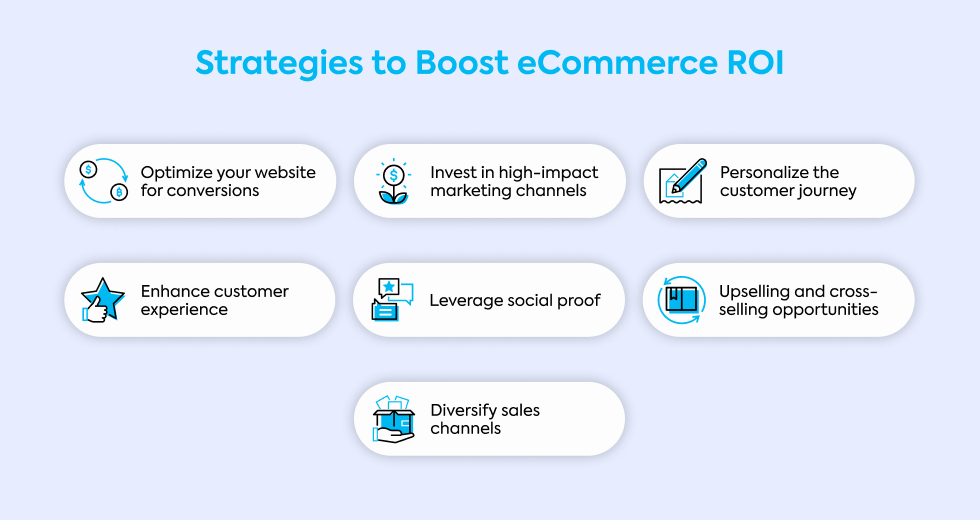
Measuring and Analyzing ROI Success
Track Key Performance Indicators (KPIs)
Tracking KPIs is essential to understanding how your business performs and pinpointing areas to improve.
Tools designed for analytics can help you monitor these key metrics and make informed decisions.
- Conversion rate measures how many visitors complete a purchase or desired action on your site. It’s a direct indicator of how well your website turns traffic into sales.
- Customer Acquisition Cost (CAC) tracks how much it costs to bring in a new customer. Lowering this expense can significantly boost your ROI.
- Customer Lifetime Value (CLV) calculates the total revenue you can expect from a customer over their time with your business, helping you focus on long-term profitability.
- Average Order Value (AOV) tells you the average amount customers spend per transaction. Encouraging upselling or bundling can increase this metric.
- Cart Abandonment Rate shows the percentage of carts left incomplete. High rates may point to checkout issues or unexpected costs.
- Return on Ad Spend (ROAS) compares revenue to the money spent on ads, helping you identify which campaigns are most effective.
- Time on Site indicates how engaged visitors are, while email open and click-through rates measure how well your email campaigns resonate with your audience.
- Social Media Engagement tracks interactions like likes, shares, and comments, showing how your brand connects with its followers.
These metrics offer actionable insights and help you understand how customers interact with your store.
Monitor Customer Behavior
Understanding customer behavior is a key strategy for improving the shopping experience.
Analytics tools can reveal how visitors engage with your site, including clicks, scrolls, and time spent on specific pages.
This kind of data helps you make decisions grounded in real activity.
Identifying drop-off points—like where users abandon their carts—is critical.
Heatmaps provide visual insights, showing which areas of your website attract attention and which ones confuse or distract visitors.
You can also track customer paths to see the flow of activity through your site.
This helps you find high-performing pages or bottlenecks that may need attention.
Data can be segmented based on demographics, purchase history, or interests to tailor your strategies further.
To refine your approach, tools like session recording allow you to watch live interactions and see exactly how users navigate your site.
That’s why it’s important to monitor not just individual actions but overall patterns of repeat visits and return frequency.
Conduct Continuous Testing
Testing is essential for refining your website and marketing efforts.
Running A/B tests on page elements—such as headlines, layouts, or call-to-action buttons—can reveal which versions lead to higher conversions.
Similarly, split testing lets you experiment with ad copy, audience targeting, or visual elements across platforms.
Adjustments to pricing strategies, discount offers, or product bundles are also worth testing to find the most effective approach.
Experimenting with email subject lines, content, and delivery times can help optimize campaigns.
Trying out new features, like chatbots or personalized recommendations, ensures you stay current with customer expectations.
Iterative tests in your checkout process can help remove friction and improve completion rates.
The goal is to use data analysis from these tests to implement strategies that drive results.
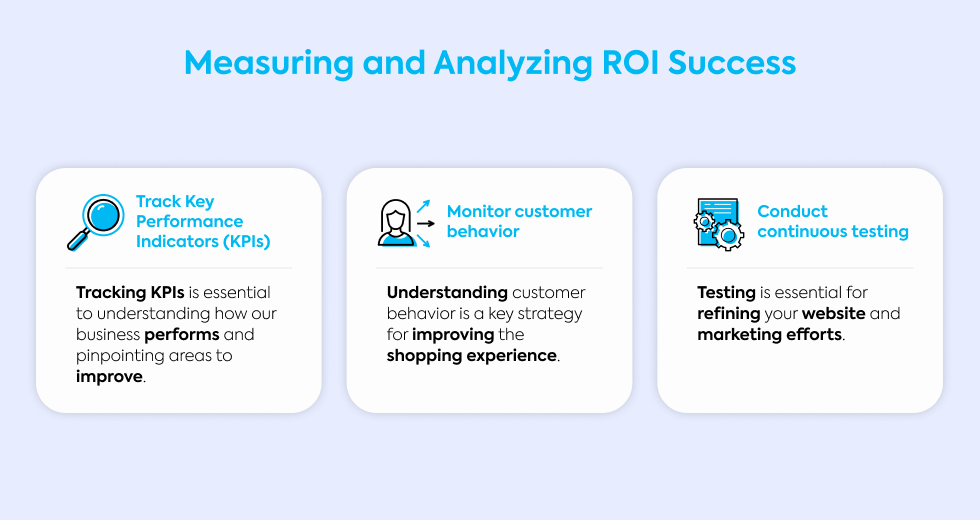
Avoiding Common Pitfalls
Overlooking Customer Retention
Customer retention is often less expensive than acquisition, making it a smart focus for increasing ROI.
Retention strategies such as loyalty programs encourage repeat purchases by rewarding customers with discounts or exclusive perks.
Personalized marketing, like targeted emails or product recommendations, strengthens relationships with your audience.
Surveys and follow-ups also give you insight into what customers need or expect.
Simple steps, such as offering an easy return process or providing excellent customer support, can enhance satisfaction and reduce churn.
Engaging with customers through social media or post-purchase communications helps build trust and loyalty.
Ignoring Data Insights
Ignoring data can leave you guessing about what works and what doesn’t.
Tracking data insights such as conversion rates, cart abandonment, or customer behavior gives you a clear picture of performance.
Tools designed for analytics can uncover patterns, helping you identify areas for improvement.
Regularly analyzing KPIs allows you to fine-tune marketing strategies or operational efforts.
Predictive analytics can help you forecast trends and anticipate customer needs.
Without this analysis, decisions are often based on assumptions instead of facts.
Regularly reviewing data ensures you’re adjusting your approach in ways that align with measurable outcomes.
Mismanaging Budget Allocation
Poor budget allocation can drain your resources and lower profitability.
It’s important to focus spending on effective strategies like SEO, PPC, or email campaigns that yield measurable results.
Tools like Google Ads Smart Bidding help you get the most out of your ad spend by optimizing bids based on performance data.
Over-relying on acquisition while neglecting retention can make costs unsustainable, so finding a balance is critical.
Diversifying across multiple sales channels reduces dependency on one platform, and monitoring spending efficiency allows you to reallocate funds where they generate the best return.
Thoughtful budget planning ensures a good ROI and avoids unnecessary waste.
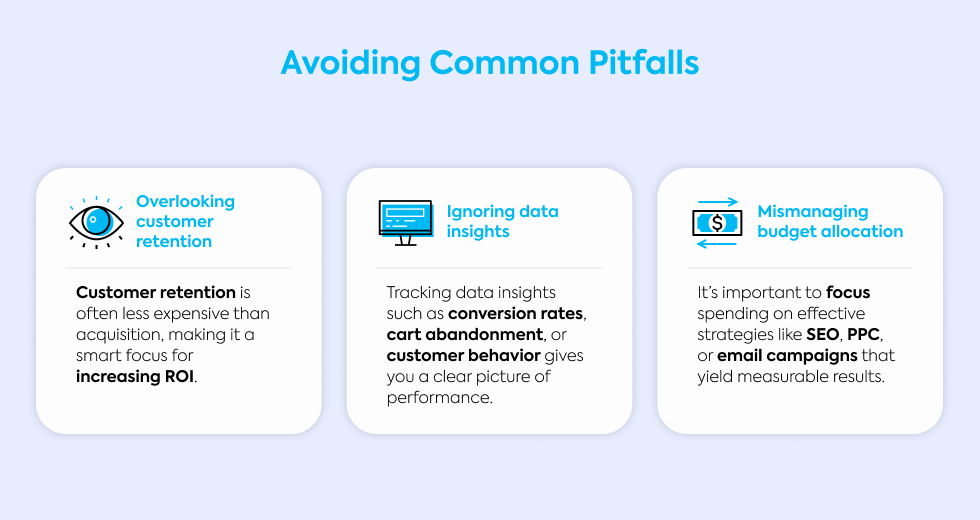
Ready to Boost Your eCommerce ROI? Let’s Talk.
Your journey to transforming your eCommerce ROI starts with the right partner.
At Gauss, we specialize in crafting custom solutions that help businesses like yours optimize websites, enhance customer experiences, and leverage data-driven strategies for better results.
Whether you’re looking to simplify your checkout process, personalize the customer journey, or diversify sales channels, we’ve got the tools and expertise to make it happen.
We understand the challenges of staying competitive in a rapidly evolving market—and we’re here to help you tackle them head-on.
Visit our eCommerce development page to see how we’ve helped others succeed. Ready to take the next step?
Contact us today to start a conversation about bringing your project to life. Let’s turn your eCommerce vision into measurable ROI.
